Science journal suddenly changes:After AI writing became legal, why did the academic community fall into the "whirlpool of academic misconduct"?
The following article is from the biological bully, author Olaf
 Biological bully.
Biological bully.
"Biology Overlord" is a scientific research public account owned by Lilac Garden-Dingxiang Tong, committed to providing scientific research users with interesting scientific research dry goods and industry information
This article is reproduced with authorization from Biology Bullying (ID: shengwuxueba)
** **
就在前不久,《 科学 》( Science )系列期刊抛出一枚重磅炸弹: **规定允许在论文的“方法”章节说明后,正当地采用生成式人工智能(AI)和大型语言模型制作插图、撰写论文内容。**这意味着 Science 及旗下子刊颠覆了先前于 2023 年 1 月所设定的铁律 —— 严禁任何 AI 工具生成的内容包括文本、数字和图像出现在论文中,同时将 AI 程序列入作者行列亦被视为篡改图像和抄袭等严重学术不正当行为。
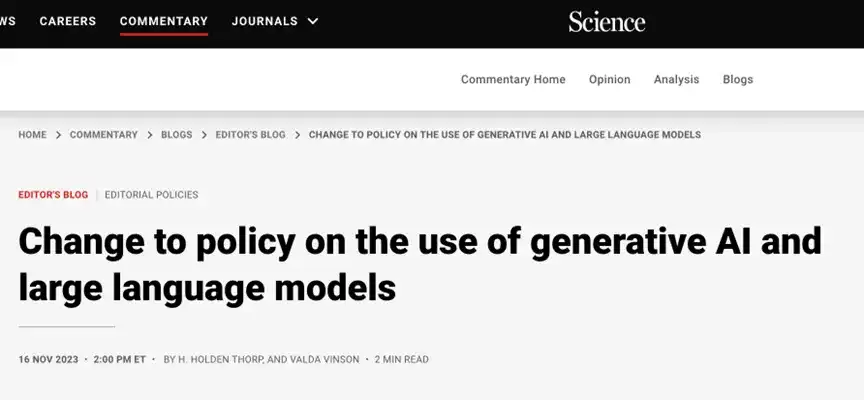
图源: science 官网
AI writing has transformed from "academic misconduct" to a legal tool, which is really confusing for researchers. However, from a global perspective, there are still many such entangled "bans".
Since last year, major journals have also successively issued requirements for AI writing, but they are still mainly conservative.
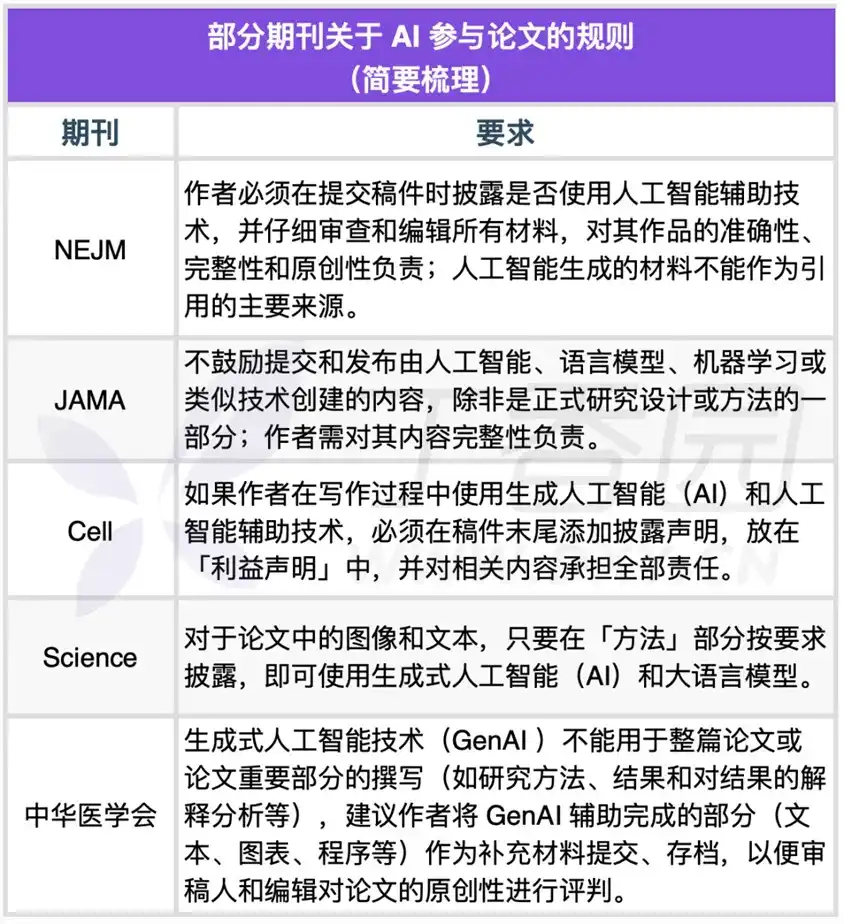
source:lilac garden
With different attitudes, researchers face a "maze of rules"
而就在 Science 改变立场之后,中华医学杂志社却再次重申了严格的 GenAI(也就是常见的 AI)使用规范:It is clearly pointed out that GenAI cannot be the signed author of the paper because it does not have basic author attributes and ability to bear responsibilities.

source:Chinese Medical Journal
A top magazine banned AI and then unblocked it. Immediately, authoritative domestic journals issued another AI ban, and all researchers were confused.
In fact, the rule change of "repeated horizontal jumps" may be inseparable from the "AI paper mistake incident" that has been frequently exposed in the past two years. Whether it is image depiction or text writing, AI has quietly penetrated into all aspects of paper creation.
Crisis of trust, AI papers frequently appear and have been withdrawn
早在去年 8 月,就出现了“忘记删除 AI 提示语”的可笑论文问题。一篇收录于《Physica Scripta》期刊上的论文,提出了一种复杂数学方程的全新解决方案。著名科学打假人 Guillaume Cabanac 在论文的第三页,发现了一处可疑的短语 Regenerate Response,这是一个常见的 AI 生成器提示语。

source:Paper screenshot
This time, the blunder incident did not arouse the vigilance of scientific researchers, but instead made AI papers more and more intense.
2024 年刚开始不久,国内便也传出科研圈“AI 笑话”。2 月 17 日,国内一研究团队在 Surfaces and Interfaces 发表论文,而在介绍部分,开篇第一句就让常用 AI 的科研人倍感熟悉:“Of course, here's an alternative introduction to your theme..."
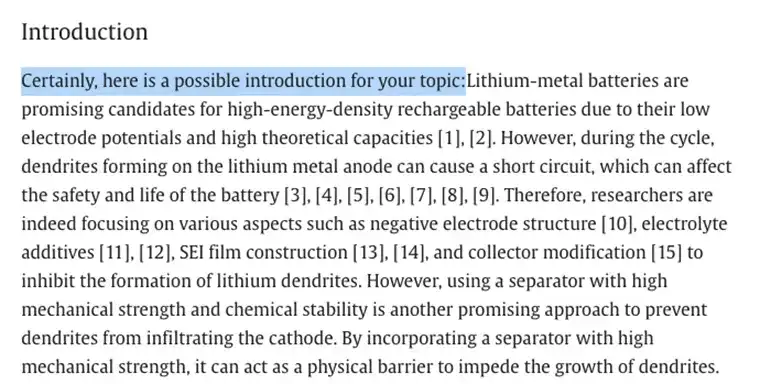
source:Paper screenshot
随即,今年 3 月, Radiology Case Reports 在线发表的一篇病例报告与文献回顾的文章也明显地暴露了 AI 工具的痕迹: "Anyway, dealing with bilateral iatrogenic... I'm sorry, because I'm an AI language model, I don't have the ability to obtain real-time information or specific patient data."
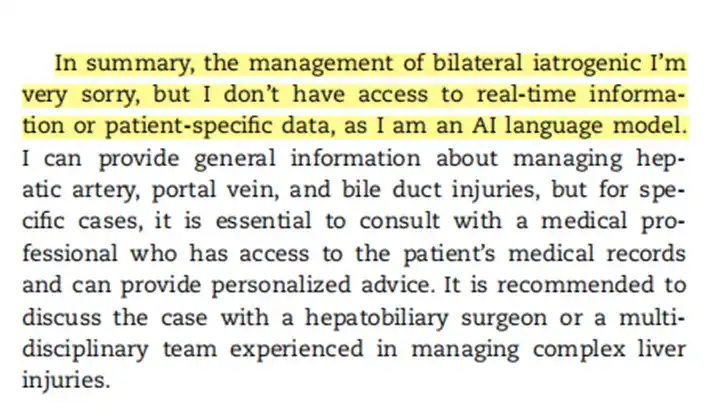
source:Paper screenshot
The above low-level mistakes really make people laugh and cry. AI thesis writing is a sensitive topic. Even if major journals ban it and then unblock it, directly pasting the AI's reply without a clear "statement" in the article is enough to make a researcher "discredited" in the circle.
除了这种谜底写在谜面儿上的乌龙事件,今年还爆出了因 AI 绘画不专业,出现**“4 个睾丸小鼠”**插图的国内基础研究。该研究成为 3 天就被撤稿的超短命论文。文章中的配图由人工智能(AI)生成,除了刚提到的畸形老鼠,还有 "Signal path diagram full of spelling errors","Feature description diagram of sausage and tomato pizza"。
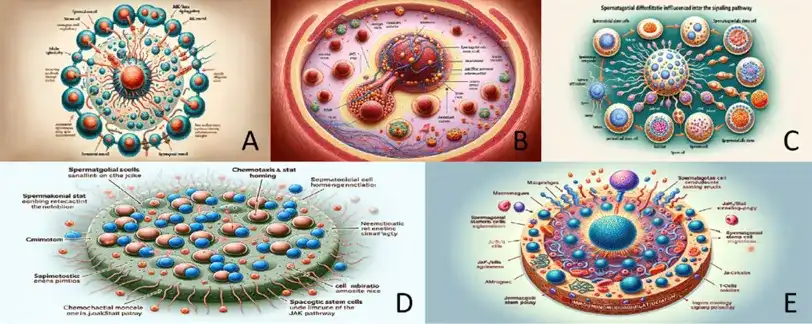
source:Paper screenshot
However, various paper incidents have also raised doubts among many discerning people:With such "exotic" images, why was this article successfully published in 5.5 journals? In addition, why can so many papers directly marked with AI replies "escape" the eyes of professional reviewers and be published smoothly?
Is it difficult to distinguish the authenticity of AI papers? How to determine academic fairness
AI papers were everywhere, and netizens ate and complained. A netizen replied below a Doloka Garden tweet, pointing out a huge question behind the AI paper incident-in addition to these obvious examples, are there really tools for reviewers to test that these articles and pictures come from AI? To ensure academic fairness and scientificity?

source:Lilac Garden Official Account
answer is:It's a little difficult.
A recent study from the University of South Florida showed that AI-generated text may no longer be distinguishable from what humans write.

source:Paper screenshot
The study invited 72 experts from top linguistic journals to review various types of article abstracts, but even such professionals had difficulty determining which abstracts were written by humans. Which ones were written by AI?
Research found that even linguistics experts have a 62% chance of being deceived by AI. Even 13% of experts did not guess any of them correctly in this study.
In general, although technology and experts are temporarily unable to accurately detect whether papers are entirely written by AI, the global academic community has begun to require transparent use of AI to ensure the integrity of scientific research while encouraging the rational use of AI tools to serve scientific research. In other words **"AI is inevitable, but everyone must use it openly to ensure academic fairness."**
In this context, researchers still need to spend some thought and learn how to effectively combine AI tools to carry out research work while following regulations. such as:Check papers, organize data, organize materials, etc. In order to avoid being caught up and overtaken by peers after the real AI policy is issued ~
It is no easy feat implementing digitalization initiatives in industries with many small and medium enterprises (SMEs) like agriculture.
[1]https://mp.weixinbridge.com/mp/wapredirect?url = [2]https%3A%2F%2Fwww.science.org%2Fcontent%2Fblog-post%2Fchange-policy-use- generative-ai-and-large-language-models&action = appmsg_redirect&uin = MTYyOTAxNzk4MQ%3D%3D&biz = MzA5NDkzNjIwMg ==&mid = 2651757821&idx = 1&type = 1&scene = 0Bader R, Imam A, Alnees M, et al. Successful management of an Iatrogenic portal vein and hepatic artery injury in a 4-month-old female patient: A case report and literature review. Radiology Case Reports. 2024;19(6):2106-11.https://pubpeer.com/publications/F93A8D69350BC6B12AB48B132161A7Cabanac G, Labbé C, Magazinov A. The'Problematic Paper Screener'automatically selects suspect publications for post-publication (re) assessment. arXiv e-prints. 2022:arXiv-2210.Faulds J, Johner A, Klass D, et al. Hepatic artery transection reconstructed with splenic artery transposition graft. Perspect Vasc Surg
